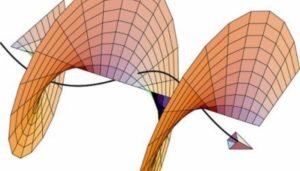
Laser-driven plasma-based electron accelerator was proposed three decades ago by Tajima and Dawson in 1983. Since then continuous research and developments are undergoing all over the world in this field. With the advancement of chirped pulse laser technology, high power ultrashort laser pulses are readily available which gives an immense push in the development of this field. The conventional radio frequency based accelerator like linear accelerator can sustain electric field gradient up to around 100 MV/m because the breaking down occurs at the wall of the structure. Also, for electron beam energy of several GeV, the acceleration length extends to several kilometers and hence increases in cost and technical challenges involved with the system.
Here, plasma-based accelerators are of great interest as plasma is already in the breakdown form (quasi-neutral gas of charged particles like electron and ions with some neutrals) that can sustain the electric field of magnitude around 100 GV/m which is approximately three orders of magnitude greater than that observed in Conventional accelerators. In the field of laser-plasma interaction, interaction phenomenon can be categorized as linear and nonlinear based on the intensity of laser pulse. The basic of laser plasma accelerator is associated with the propagation of highly intense laser pulse (having an intensity above the relativistic threshold) through the underdense plasma. As the laser pulse propagates through underdense plasma it creates a plasma wave behind it. This wave can be pictured as the wake created by a boat behind it when it is moving in the sea. The electric field gradient associated with these longitudinal plasma waves is in the range of 100 GV/m, whenever electrons get trapped in this high electric field they get accelerated to high energy in the small distance (within few mm or cm). That’s why these acceleration mechanisms are called Laser Wake Field Acceleration(LWFA).
Trapping of the electrons in plasma wave takes place as the result of plasma wave breaking. Plasma wave-breaking is that situation when plasma wave amplitude becomes maximum and some of the electrons go out of the plasma wave structure and get trapped by the plasma Wakefield. In general, the energy gain by electron bunch in plasma wakefield can be estimated by the product of electric field and the length it travels before the decelerating phase of plasma wave (called dephasing length). However, the acceleration mechanisms seem to be straightforward but there are many challenges and difficulties associated with it to practically achieve good quality electron beam. The characteristics of the beam like divergence, charge, energy etc, depends on laser and plasma parameters. On the side of laser parameter it needs to be focused to micron range and at the same time must propagate longer distance, due to the natural diffraction of laser it comes out to be a difficult task. Some methods like self-focusing, heater igniter method(using two laser pulse) preformed plasma channel etc. are explored to propagate focussed laser beam to several Rayleigh length.
On the other hand plasma parameter like density also plays a vital role in achieving accelerating particles. Some of the parameters like electric field, dephasing length, laser depletion length etc. have density dependence, hence it needs to be optimized for good result. Moreover one of the important issues is the trapping of the electrons at the right phase(accelerating phase), there are some techniques which externally inject electron at the right phase to have maximum energy gain by the electrons. Despite all these challenges associated with acceleration processes a wide number of experiments are reported which shows higher energy gains, low divergence and increased the charge. In the current scenario, high power laser source (Petawatt lasers) are developed which are utilized to carry out electron acceleration experiments. With time better control will be achieved over the parameters associated with acceleration mechanisms. Recently using preformed plasma channel 4.2 GeV energy electron beam is reported in the 9cm long capillary tube. However much research and development are needed to achieve tabletop accelerators reach higher untouched regime of energy
Written by: Saurabh Kumar and Krishna Gopal



